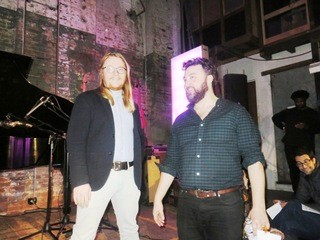|
Back
The Life of a “Dying Fall” New York
Spectrum, 70 Flushing Avenue, Brooklyn
11/20/2017 - & February 8, 2018 (Part II)
Scott Wollschleger: Complete Works Part I: For Nils (World Premiere) – Gas Station Canon Song (New York Premiere) – Secret Machine No. 4 – In Search of Lost Color – Dark Days – Tiny Oblivion – Gas Station (original two-piano version)
Karl Larson (Pianist)

K. Larson, S. Wollschleger at Spectrum (© Samuel A. Dog)
“...I was searching for a kind of music that would exist after the world ended.”
Scott Wollschleger, from Pages for Piano program notes.
Alas, Mr. Wollschleger was preempted by director Lars von Trier, whose end-of-world music for Melancholia was the Tristan Act I Prelude. But those notes came from a linear time where even stretched out tonics and dominants followed Newton’s exacting rules. (And, perhaps accidentally, Trier chose Tristans beginning to signal our end.)
Thirty-six-year-old Scott Wollschleger is the product of a quantum universe where nothing is as it seems, where modus operandi depend on our point of view, where waves and particles eternally change bodies. And where death (as he notes in Tiny Oblivion,) is that we turn into those particles...“spreading out over unfathomable vast distances in an ever expanding and cooling universe.”
Mr. Wollschleger was in attendance for his favorite pianist, Karl Larson, playing seven of his quark-ish piano works last night at Spectrum. True, Spectrum’s Brooklyn neighborhood is a semi-dingy area of warehouses, open lots, a few rats and the Brooklyn Navy Yards. Inside Spectrum, though, one feels cozy and comfortable. Totally enclosed, guitars on the wall, an ancient coat-of-arms up high (or it could have been a furnace), pianist Karl Larson meeting visitors eating a banana (try that, Emanuel and Marc-André), free wine, and free talk among listeners, all of whom seemed to know each other as well as the easy-going young composer.
His choice of Mr. Larson, who was on his debut album last month, was simply explained. The piano, said Mr. Wollschleger before the program, is a percussion instrument, but Karl Larson pianist understands all the nuances, the changing of colors and timbres, the rising and the dying of sounds.
For the first three works, this was oh so true. I haven’t seen the score, but don’t believe Mr. Wollschleger ever wrote an ad libitum. Mr. Larson’s notes–the clusters, the single cells, the constant changes from top to bottom of the keyboard (a trademark of all Mr. Wollschleger’s work)–were played with that precise sense of conscious lassitude, of tones and colors fading and lifting themselves up and then plunging down again.
One thinks inevitably of Duke Orsino describing “that strain again,...a dying fall.” But Mr. Wollschlegger had his own language far far from Shakespeare. His repetitions are oh so close to Morton Feldman. But Feldman’s longueur can be soporific as well as languorous. Mr. Wollschleger’s music is always interesting, even when it pretends to be simple repetition.
His opening Gas Station With Double Canon is as far from Virgil Thomson’s Gas Station as possible. The latter was jolly, all-American. Mr. Wollschleger’s Gas Station is desolate, a short and lonely series of piano lines and a few chords putting one in...well, in a mood of withdrawal, remoteness.
The only piece which dramatically, perhaps uncomfortably changed moods in the middle was Secret Machine No. 4. We had those fascinating chords with the tinkly replies for the first half. And abruptly, for the only time last night, Mr. Wollschleger chose a romantic series of French sonorities, a kind of Satie-Ravel phrasing rolling down the keyboard.
I didn’t see how Mr. Larson managed those legato passages. His foot was never (or barely) on the pedal. But he does have that feather-light sensitivity which can accomplish it.
The third of the first group, For Nils was dedicated to Mr. Wollschlegger’s teacher, Nils Vigeland, with music Vigeland, Ives and of course Wollschlegger himself. It was the only work with humor, a series of fanfares–all in the same key, all repeated almost endlessly before going into the quotes.
The last four works were longer (though not more complex on first hearing). They didn’t have themes so much as intervals. Chords on the top and bottom of the keyboard, sometimes tapping on the wood. They didn’t build, the structure was a stasis. Nobody who attends a fairly Minimalist program (and Mr. Wollschleger might resent the M-word) expects much structure in any classical form, but if the stream of notes lies in its own pool, either swirling around or ascending and descending back to the same area, one begins to tire of it.
Yet this was my fault entirely. Perhaps I was simply listening to it, rather than falling into a meditative coma. Or perhaps the deviation in nuance, the languishing, melting and starting again was too vaporous for my limited comprehension. And when those tinkly soprano notes began to sounds like post-nasal drip, I realized that my ears had outworn their welcome.
I did love Mr. Wollschleger’s original ideas, I loved Mr. Larson’s so finespun touch, the subtlety and aurally exact performance. And a few of Mr. Wollschleger’s works floated, ascended and offered the clarity of a barely brushed church window. An hour was a wee bit too much (I was stupidly looking for a few measures of grandeur), but so often Mr. Wollschleger’s minutes gave out the scintilla of radiance.
Harry Rolnick
|